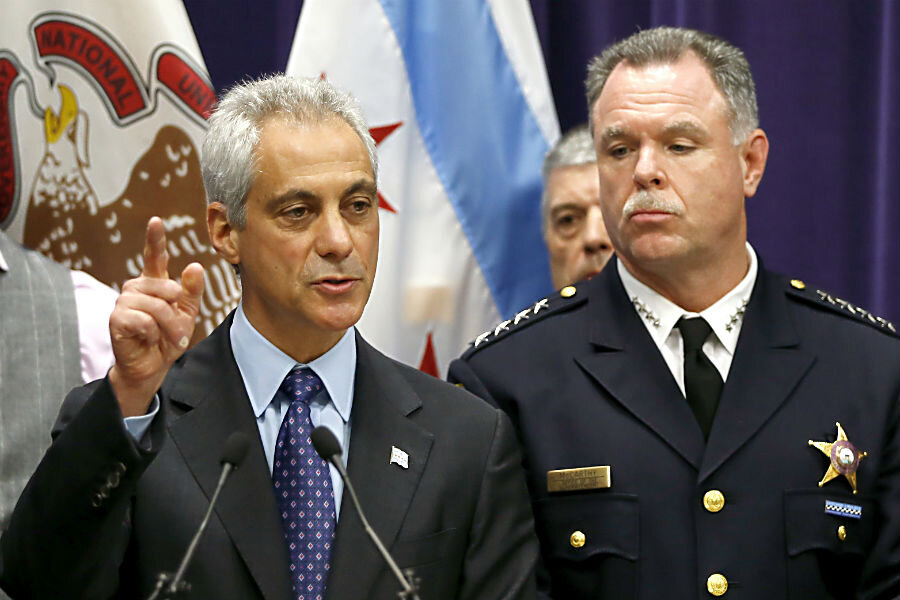Chicago police shooting video: Questioning the value of transparency
Loading...
In a long-awaited case that has galvanized tensions over police violence in Chicago, local prosecutors released a graphic video showing a white officer shooting a black teenager 16 times on Tuesday.
The officer, Jason Van Dyke, has been charged with murder and jailed in the killing of 17-year-old Laquan McDonald, with prosecutors defending the 13-month delay in charging the officer and insisting the video’s release was not related to the delay.
“It is graphic. It is violent. It is chilling," Cook County State’s Attorney Anita Alvarez told the Associated Press. "To watch a 17-year-old young man die in such a violent manner is deeply disturbing. I have absolutely no doubt that this video will tear at the hearts of all Chicagoans."
But unlike other police shootings, in North Charleston, S.C., Boston, or Minneapolis, where protesters continue to call for the release of video of the shooting of Jamar Clark, an unarmed black man who was killed while reportedly handcuffed in police custody, the video of Laquan’s death was not hailed as a moment of transparency.
Instead, a diverse group of people, including some community activists, the teen’s family, Chicago mayor Rahm Emanuel and the police department sought to block its release for different reasons. Its release was ordered by a judge last week after an independent journalist sued to obtain the video.
The video’s release prompted several small, nonviolent protests across the city, including in the city’s West and near South Side, with protesters briefly gathering near the police department’s headquarters, the AP reports. There are expected to be several protests, including a gathering at City Hall on Wednesday and a protest seeking to block Michigan Avenue’s shopping district during Black Friday.
In the days before the video’s release, some community activists worried about the impact of the graphic video, which shows Officer Van Dyke firing at Laquan almost immediately after he and another officer get out of a car with their guns drawn.
While in Minneapolis protestors clamor for the release of video showing the shooting of Jamar Clark, in Chicago there was less unanimity among the various interested parties about the value of a public viewing.
“If the family didn’t want this released, then [public airing of it] just adds to the injustice,” Page May, an activist with the group We Charge Genocide, told The Chicago Reporter. “This video is about to be seen by millions of people. If [a police officer kills me], I don’t want my body turned into a viral video."
Mayor Emanuel, who had previously argued releasing the video could lead to violent confrontations such as those in Baltimore and Ferguson and has objected to characterizations of violence in Chicago as “Chiraq,” the title of a forthcoming film about the city by Spike Lee, appeared to have softened his stance.
He described the video’s release as a potential "moment of understanding and learning,” the AP reports.
In Minneapolis on Tuesday night, a day after a shooting left five people injured, the mood outside a Minneapolis police precinct was also calm, with many protesters aimed at bringing transparency around the shooting of Mr. Clark returning to the site, ABC News reports.
"We ain't scared," Minneapolis NAACP President Nekima Levy-Pounds told a large crowd gathered for a concert at the precinct early Tuesday evening, the station reports. "We can't back down. We ain't turning around, but we're here fighting for justice."
The protests had been marred by several threats of violence against the protesters which escalated into a shooting by several people who had been standing near the protests on Monday night.
Rep. Keith Ellison (D) of Minnesota, who was at Tuesday’s protest, said despite the calmer mood, he still had some safety concerns. "The Jamar Clark family has urged us to start thinking about an exit strategy, and I think that would be wise,” he told ABC.
But in Chicago, some activists questioned whether the release of the video showing Laquan’s death had prompted prosecutors to charge Officer Van Dyke with first-degree murder after long delays.
“This is a panicky reaction to an institutional crisis within the criminal justice system," the Rev. Jesse Jackson told the AP, adding that he hoped to see "massive" but peaceful demonstrations.
The teen, who was suspected of slashing the tires of a police cruiser, appeared to be veering away from officers and was shot twice in the back, according to the Associated Press. An autopsy revealed that he was reportedly under the influence of the drug PCP at the time. Police have said the teen had a knife. Cook County State's Attorney Anita Alvarez said that a 3-inch pocket knife with its blade folded into the handle was recovered from the scene, reports the Associated Press.
Prosecutors said the shooting lasted 14 or 15 seconds and that Laquan was on the ground for 13 seconds, while Van Dyke’s attorney, Dan Herbert said his client feared for his life, adding that the video does not tell the whole story.
There are expected to be several protests, including a gathering at City Hall on Wednesday and a protest seeking to block Michigan Avenue’s shopping district during Black Friday.
"It's powerful we're coming together," Justin Taylor, an 18-year-old student at the University of Iowa who returned home to Chicago for Thanksgiving, who was at one of the protests, told the AP. "Things like this happen too often."
Material from the Associated Press was used in this report.







